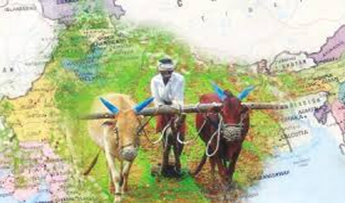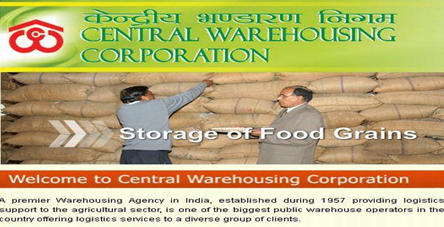Marketing Aptitude: Agricultural Marketing in India
Agriculture is the backbone of the Indian economy. It contributes approx 25 % of National Gross Domestic Product (GDP). In India, agricultural product is the 4th largest exported principal commodity with a share of 10 % of total exports. Over 58 % of the rural households depend on agriculture as their principal means of livelihood. Agriculture, along with fisheries and forestry, is one of the largest contributors to the Gross Domestic Product (GDP). As per estimates by the Central Statistics Office (CSO), the share of agriculture and allied sectors (including agriculture, livestock, forestry and fishery) was 15.35 % of the Gross Value Added (GVA) during 2015–16 at 2011–12 prices.

In today’s scenario, agricultural marketing is necessary not only to boost India’s economy but also for the welfare of farmers. It is the economic process through agricultural goods are exchanged. The importance of agricultural marketing has been defined as under:
- Royal Commission on agriculture (1928): – “Problem of agricultural growth cannot be fully solved unless agricultural marketing is improved.”
- National Commission on Agriculture (XII report): – “Agricultural marketing is a process which starts with a decision to produce a saleable farm commodity and it involves all aspects of market structure of system, both functional and institutional, based on technical and economic considerations and includes pre and post- harvest operations, assembling, grading, storage, transportation and distribution.”
- Farque: – “Agricultural Marketing comprises of all operations involved in the movement of the agricultural produce from the producer to the final consumer. Thus, agricultural marketing is a specific part of marketing which is related to agricultural products.”
Defects of Agricultural Marketing system in India
The agricultural marketing in India suffers from many defects. Some of the noteworthy defects are as under: –
- Lack of farmers’ organization: – Indian farmers lack collective organization. In the agricultural mandis, millions of small farmers brought their produce separately, which causes high transport cost and low-bargaining power.
- Lack of grading & standardization: – The rural farmers are not aware of the impact of grading and standardization of their products. Due to this unawareness, the dishonest functionaries in the market take undue advantage of farmers. They may declare any produce as low-grade and quote a low price for such stocks, which in turn create a big loss to farmers.
- Lack of transport facilities: – There is a lack of economical and fast means of transport between the rural and urban areas such as absence of the transport facility in agricultural marketing areas, high goods charges due to inadequacies, seasonal transporting services, lack of all-weather roads and transport vehicles, lack of transport facilities for transportation of some products like fruits, vegetables, eggs, etc., from rural areas. Due to these problems, transportation cost goes high and farmers force to sell their goods to the middlemen and nearest mandis at low prices and not able to get full benefit of their hard work & quality of their products.
- Lack of storage facility: – In rural areas, farmers do not have proper storage facilities to store their produce to sell later at a better price. Many times crops are dumped in the places which are vulnerable to pests and insects. For this reason, farmers are compelled to sell their produce at low price.
- Lack of finance: – Small and poor farmers do not get easy credit facilities through banks or from any co-operative societies due to lack of security, poor credit history, etc. With this, farmers are force to take loan from traders and moneylenders to run their agricultural activities smoothly. They are force to accept the unlawful conditions (or provisions) of money lenders/ traders. Due to this very reason, farmers are compelled to sell their produce at low price.
- Lack of Market Intelligence: – Farmers do not have adequate information about the prices that prevail in big and organized markets due to ignorance, illiterateness, lack of technological advances, etc. Due to this, they mainly depend on the commission agents on the price of their produce and sell their produce at low price to nearby markets.
Remedial Measures for Agricultural Marketing system in India
Some of the following measures are taken by Indian Government to improve agricultural marketing system in India-
- Establishment of regularized and controlled mandies: – The Government of India (GoI) has established the regularized and controlled mandies to protect the farmers from illegal and unhealthy trading practices. These mandies helps in reducing the marketing charges to benefit the poor farmers and also helps in ensuring fair prices both to producer and consumer. These markets are managed by market committees, which consist of representatives of business men, farmers, Government, etc. To work in these mandies, businessmen and brokers have to obtain license from these committees. Here, weights and measures are used under the strict supervision of the committees. To supervise the development of these regulated markets, the Indian Government has set up the Directorate of Marketing and Inspection (DMI), Faridabad.
- Gradation of Agricultural produce: – To improve the grading and marking of agricultural and other produce, the Agricultural Produce (Grading and Marking) Act of 1937 (and amended in 1986) was introduced. According to the provisions of this Act, the standards are determined by the Government of India (GoI) and the responsibility of classification of goods is taken over by the institutes appointed by the Government. Such as, “AGMARK, a certification mark, is legally enforced in India by this act. Currently, AGMARK standards cover quality guidelines for 213 different commodities spanning a variety of Pulses, Cereals, Essential Oils, vegetable oils, Fruits & Vegetables, and semi-processed products like Vermicelli. To testify and certify the products in India, in addition to the Central AGMARK Laboratory (CAL) in Nagpur, there are Regional AGMARK Laboratories (RALs) in 11 nodal cities viz. Mumbai, New Delhi, Chennai, Kolkata, Kanpur, Kochi, Guntur, Amritsar, Jaipur, Rajkot and Bhopal.
- Standardization of weights and measures: – To guarantee standardized weights and measures in trade and commerce, the Government of India (GoI) adopted the metric system of weights and measures in 1958. With the introduction of this system, many problems of measurement and weighing have been solved in the country. To ensure uniformity in matter of enforcement, the Standards of Weights and Measures (Enforcement) Act, 1985 was passed by the Parliament of India. It contains provision for effective legal control on weights and measures and protects the consumers by ensuring accuracy in weights and measures.
- Establishment of Co-operative Marketing Societies: – The Government of India (GoI) has set up Primary Agriculture Credit Cooperative Societies (PACS) to protect the interests of farmers. These are the bottom-tier of the Short Term Cooperative Credit Structure functioning at the grassroots (Gram Panchayat) level and are owned by farmers, rural artisans, etc. The PACS helps the member farmers by providing storage and marketing services of agricultural produce, by providing credit facility at affordable interest, by creating awareness among them to adopt improved farming practices, etc.
- Advertisement of agricultural marketing information: – The Government of India (GoI) has set up many news channels and programmes such as Doordarshan (DD) Kisan channel, Prasar Bharati’s ‘Krishi Darshan’ programme, etc., to broadcast the market information for the benefit of farmers. These channels and programmes not only helps the farmers to know the rates of their products in the various mandis / markets of country but also helps them to know the new farming techniques, water conservation, organic farming, etc.
- Facility of warehouses: – To improve storage facility for the farmers, the Government of India (GoI) has set up many agencies for the construction of godowns (or warehouses). Some of the agencies are Food Corporation of India (FCI), Central Warehousing Corporation, State Warehousing Corporation, etc. These warehouse operators not only provide services in the area of storage and handling but also in clearing & forwarding, transportation, procurement, distribution, etc. They also provide consultancy services or training for the construction of warehousing infrastructure to different agencies and other ancillary activities.

- Stability in Price: – The Government of India (GoI) has adopted Minimum Support Price (MSP) scheme, at which government purchases crops from the farmers, whatever may be the price for the crops. The MSP offers an assurance to farmers that their realization for the agricultural produce will not fall below the stated price. It also protects farmers from any sharp fall in the market price of a commodity. The government decides the support prices for various agricultural commodities viz. wheat, rice, paddy, maize, bajra, cotton, etc., on the basis of the recommendations made by the Commission for Agricultural Costs and Prices (CACP). It considers factors such as the cost of production, change in input prices, market price trends, demand and supply, and a reasonable margin for farmers.
- Financial Facilities: – The Government of India (GoI) has set up many agencies and institutions for the upliftment of rural India by increasing the credit flow for elevation of agriculture & rural non farm sector. These are National Bank for Agriculture and Rural Development (NABARD), co-operative banks, commercial banks, Land Development Bank (LAB), etc.


